Alutech Fanes 29 Custom in review – A distinctive alloy bruiser from Germany
With its striking alloy frame and generous 170 mm of travel front and rear, the Alutech Fanes 29 Custom has already been around for a few years. We put our test rig through the wringer to find out how well it has aged, and whether the concept can still keep up with the best modern enduro bikes.

14.5 kg in size L | € 7.039 | Manufacturer’s Website
The Fanes Custom retails from € 4,430 and features a lightweight alloy frame generating 170 mm rear travel. Sounds interesting, right? Our test bike in size L tips the scales at just 14.5 kg and costs a reasonable € 7,039 with a SRAM GX drivetrain and RockShox Ultimate suspension. Moreover, Alutech’s extensive online configurator ensures a very pleasant buying experience! Read our full review to find out how the Alutech Fanes fared in our test.
Over the past 20 years, Alutech’s CEO Jürgen Schlender has made a reputation for himself as one of the underdogs in the German bike industry. To begin with, the frames were manufactured in Germany, but as the brand grew, production was moved to Asia. When the COVID-19 pandemic struck, forcing manufacturers to shorten their supply chains, Alutech brought production back to Germany, where they’re still welding and painting their frames to this day. And while their name suggests a thorough commitment to metal, the German manufacturer takes a rather unconventional approach with their frames, combining an alloy main frame and lightweight carbon swingarm – exactly the opposite of what most other manufacturers do, pairing a carbon frame and aluminium rear end.
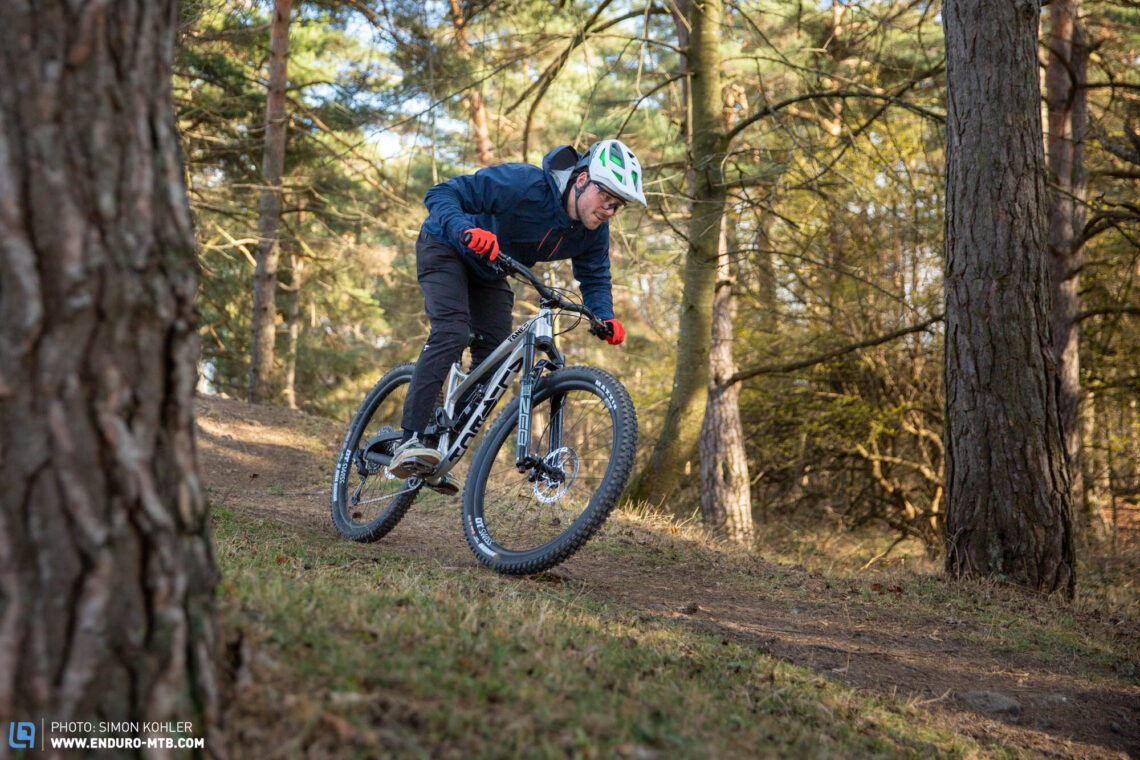
The Alutech Fanes 29 Custom in detail
With its hydroformed tubes and futuristic design language, the Alutech frame looks straight out of a sci-fi movie. The chunky weld seams exude robustness, but are rather rough compared to bikes from other manufacturers. That said, our Fanes 29 test bike still relies on an older frame produced in the Far East, while the newer bikes welded by Jürgen in Germany should be more refined! The cables disappear into the frame through conventional cable ports on the down tube rather than through the headset – a trend that seems to become increasingly popular amongst manufacturers. The cables are securely clamped at the ports without any ugly kinks, ensuring a quiet ride even on rough trails. The cables are routed just as neatly at the transition from the main frame to the swingarm, where they exit the frame just above the bottom bracket only to disappear into the cross-brace of the swingarm.
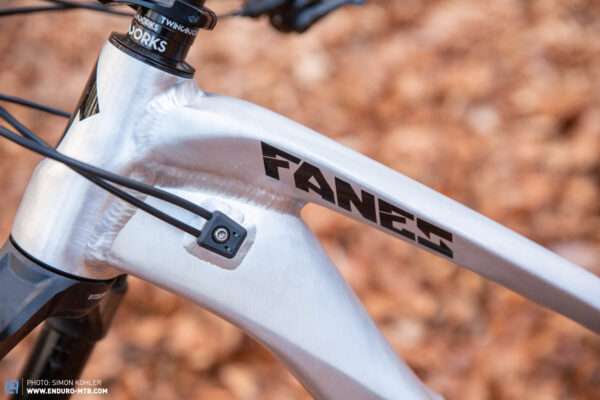
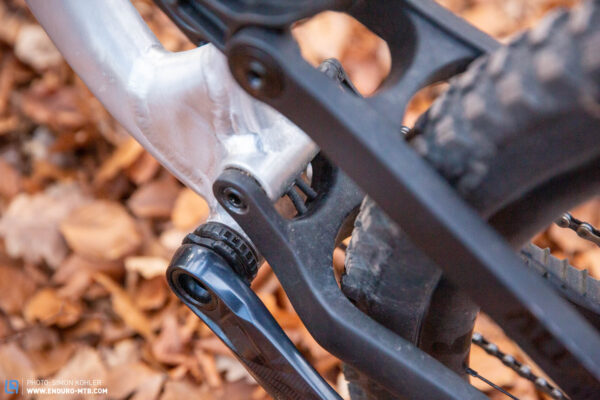
Unfortunately, the frame doesn’t feature mounting points for a bottle cage or tool mount, making a tool strap mandatory if you want to secure a spare inner tube or multitool to your bike. This also means that you’ll have to carry a hip pack or backpack with your water supply, or, alternatively, find a custom bottle cage system that fits the bike – annoying! While hydration might be a major issue with the Alutech, rattling noises aren’t, with the soft chainstay protector effectively preventing chain slap on all trails. The Fanes could benefit from a down tube protector too – while this isn’t a must with an alloy frame, it would be a welcome addition to maintain the appearance and value of the bike.
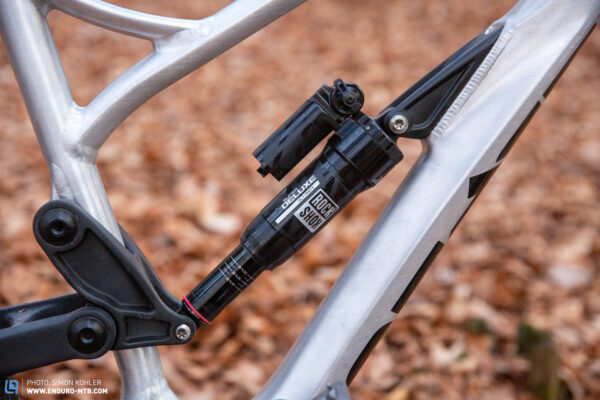
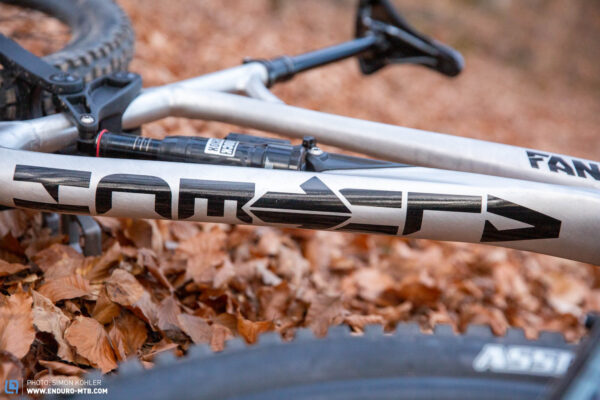
The Alutech configurator – Almost no wished unfulfilled
Alutech’s website features a pretty extensive online configurator. The Fanes is available in three different wheel size options: 27.5”, mullet and full 29”, which are all available as a frame kit too. Once you’ve selected the wheel size, you can pick your components and finish to suit your needs and preferences, with prices starting at € 4,430 for the standard spec. While the brushed alloy frame looks pretty darn good as it is, for an additional € 229.90 you can choose a finish from the RAL samples in the configurator – we like it!
For the suspension, you can choose between FOX, RockShox and Formula and the frame is compatible with both air and coil shocks. There’s also a big choice of brakes, with different options from Formula, SRAM, and MAGURA. While we don’t recommend Formula’s two-piston stoppers for this style of bike, their four-pot model is a solid yet affordable option for your next bike. The configurator also includes four dropper post options with travel between 150 and 213 mm. However, when choosing your post, you should take into consideration the frame’s short 260 mm maximum insertion depth, which prevents you from inserting the 213 mm BikeYoke REVIVE model all the way into the frame, since this requires 295 mm insertion depth. The rest of the spec can be freely configured, from the bashguard to the chain guide and even the decals. Unfortunately, the choice of tire is limited to just two MAXXIS models: ASSEGAI with 3C MaxxTerra compound, and Minion DHR II in DualCompound. Moreover, the configurator doesn’t tell you which casing you’ll get with your bike, though this might just be due to the current stock shortages.
The spec of our Alutech Fanes 29 Custom test bike
The suspension consists of a 170 mm RockShox ZEB Ultimate 2023 fork with Charger 3 damper, and a RockShox Super Deluxe Ultimate RCT 2023 shock, both with externally adjustable low- and high-speed compression and rebound settings. This is a very solid setup and, as usual, both the fork and shock deliver a tremendous performance on the trail.
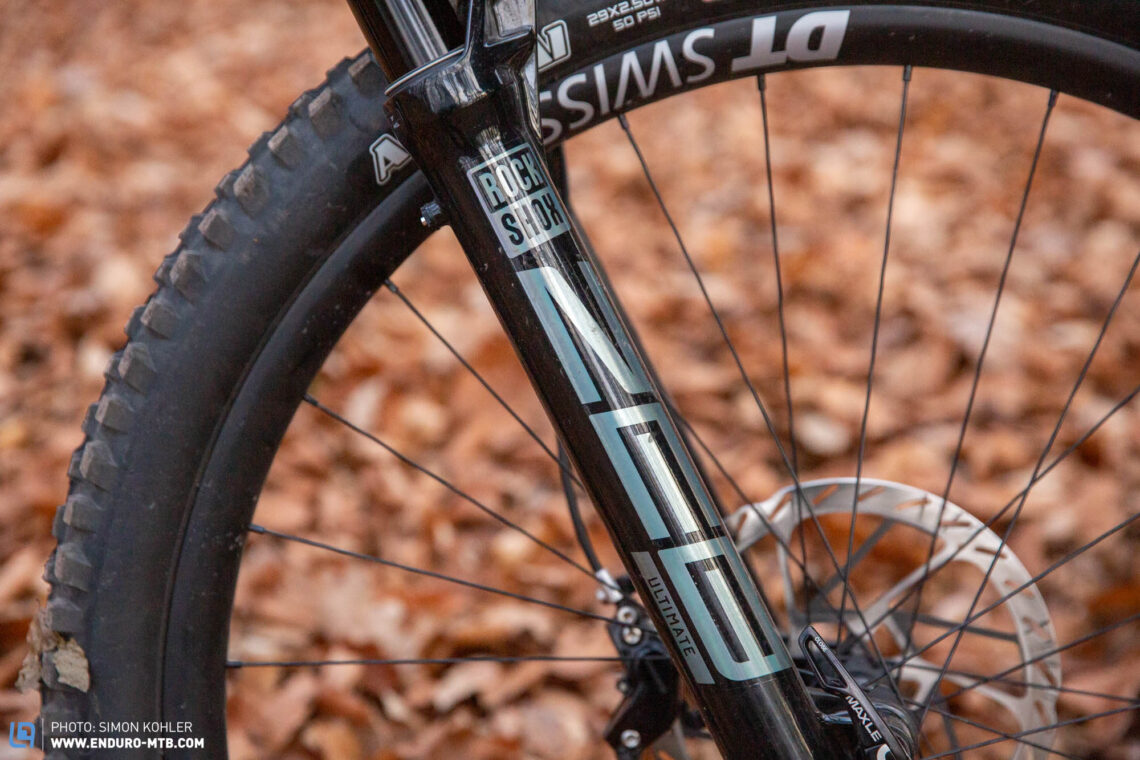
Our test bike rolls on a MAXXIS tire combo with an ASSEGAI at the front and a Minion DHR II at the rear. While this is an excellent setup per se, both tires come in the thin EXO casing, combined with hard MaxxTerra rubber compound upfront, which is an absolute no-go for modern enduro bikes, especially in combination with the DT Swiss EXC 1501 carbon wheelset. We recommend upgrading to more robust tires with a tougher casing, which have better damping qualities and protect the expensive rims against impacts. If you want to stick to MAXXIS tires, you should combine their DoubleDown casing at the rear and slightly lighter EXO+ casing at the front, which provide the ideal setup for enduro riding. While you’re at it, you should use a softer rubber compound on the front wheel for more traction too.
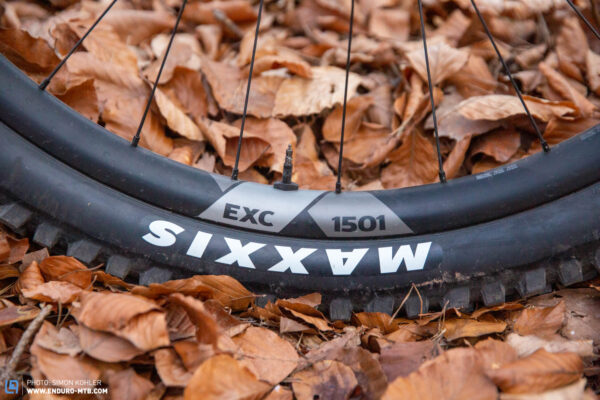
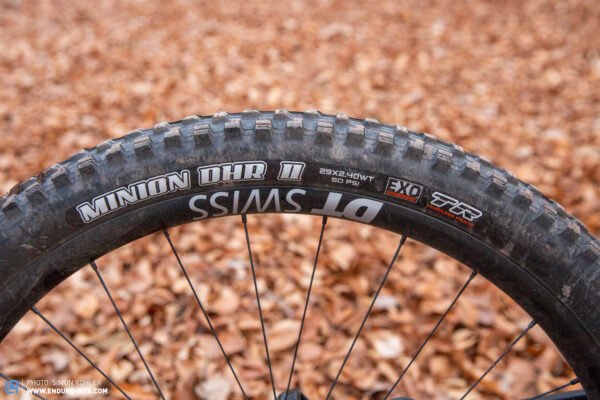
Our Fanes test rig relies on powerful SRAM CODE RSC four-piston brakes with a 200 mm rotor at the front and 180 mm disc at the rear. That said, a potent bike like this deserves two big 200 mm rotors, because they deliver more braking power without overheating as quickly. Unfortunately, this option isn’t available in Alutech’s configurator, but swapping the rear disc is a quick and relatively cheap upgrade, and only requires you to buy a brake mount adapter and, of course, a bigger rotor.

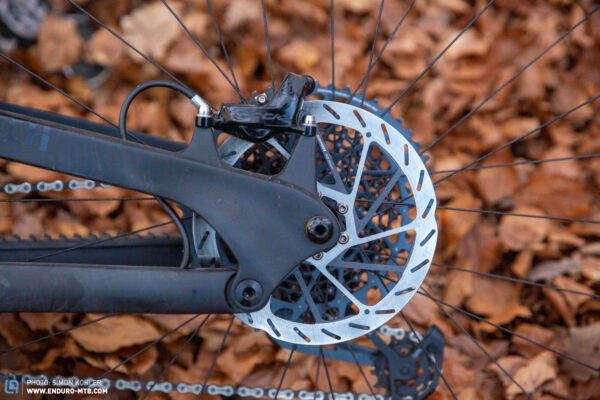
SRAM supply the 12-speed GX Eagle drivetrain which, as usual, offers an excellent price to performance ratio. For the dropper post, Alutech rely on a 185 mm BikeYoke REVIVE, which is quick and easy to bleed: just undo the screw on the side, drop the post all the way down, re-tighten the screw and off you go. While there’s also a 213 mm version of the REVIVE to choose from the configurator, even the shorter 185 mm version on our size L test bike doesn’t slide all the way into the frame. According to Alutech, however, the production frame will be modified to offer 260 mm insertion depth across all frame sizes, so you should be able to slam at least the 185 mm post. The cockpit consists of a 35 mm TwinWorks CNC stem and 780 mm SQlab 30X Carbon High handlebars with massive 45 mm rise, 12° backsweep and 4° upsweep, which should all contribute to a very healthy wrist position.

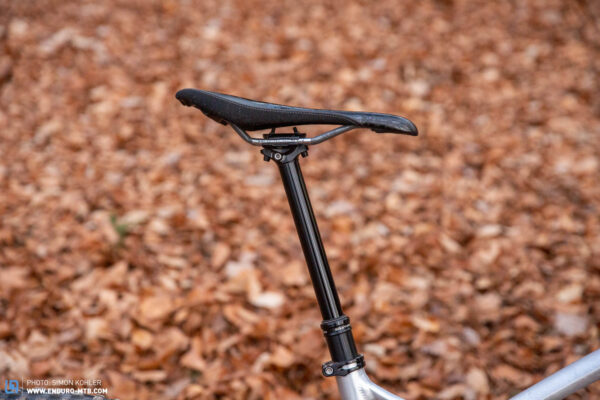
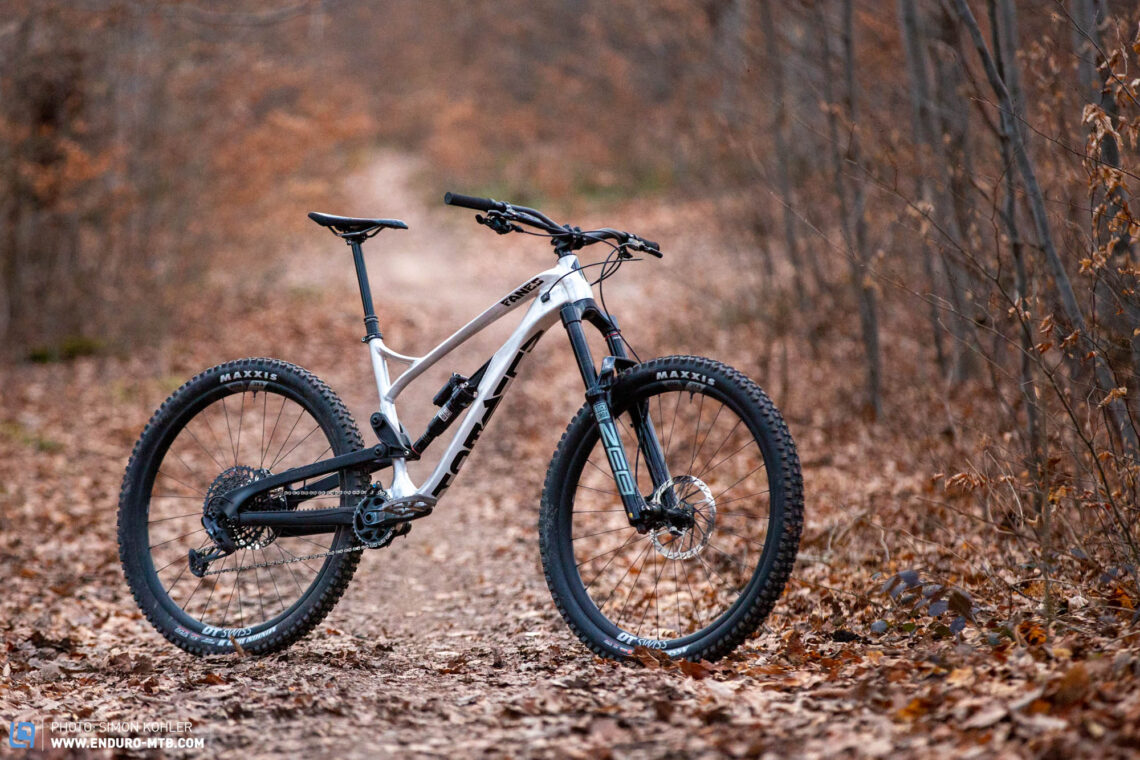
Alutech Fanes 29 Custom
€ 7,039
Specifications
Fork RockShox ZEB Ultimate RC2 170 mm
Rear Shock RockShox Super Deluxe Ultimate 170 mm
Seatpost Bike Yoke Revive 185 mm
Brakes SRAM Code RSC 200/180 mm
Drivetrain SRAM GX Eagle 1x12
Stem TwinWorks CNC mm
Handlebar SQLab 30X Carbon high 780 mm
Wheelset DT Swiss Laufradsatz EXC 29"
Tires MAXXIS ASSEGAI MaxxTerra EXO/MAXXIS MINION DHR II Dual Compound EXO2,5"/2,4"
Technical Data
Size M L XL
Weight 14,5 kg
Specific Features
Aluminum frame / carbon rear triangle
No tool mount or possibility for bottle cages
The spec of the Alutech Fanes 29 Custom for the price conscious
Since Alutech offer a lot of customisation through their online configurator, the editorial team decided to put together a spec that strikes the best balance between price and performance. Here’s what we came up with:
Starting with the wheels, we would pick a DT Swiss E 1700 wheelset, because it strikes an excellent balance between price, weight, and durability. In addition, alloy rims are generally more compliant than carbon ones, which makes the bike more forgiving to riding mistakes. In our opinion, this setup really benefits the overall handling qualities of the Fanes.
For the fork, we would go for a 2022 RockShox ZEB Ultimate RC2, which looks almost identical to its 2023 counterpart but relies on completely different internals. The biggest difference is that the 2022 version relies on a Charger 2.1 damper, while the latest iteration employs the all-new Charger 3 variant. That said, the 2.1 damper still delivers a killer performance on the trail while at the same time saving you a decent amount of cash – up to € 200 on the configurator at time of writing. As far as the shock goes, we’d pick the latest 2023 RockShox Super Deluxe Ultimate RCT, which, unlike its predecessor, offers externally adjustable high- and low-speed compression adjustments, allowing you to fine-tune the shock to your needs and preferences.
What about the brakes? We say Formula! However, make sure you pick the Cura 4 four-piston model instead of the standard 2-pot brakes, because the € 100 surcharge is well worth it, and a potent bike like the Fanes calls for powerful brakes – after all, you want to be able to stop at some point ;). For our custom build, we would choose the same SRAM GX Eagle 12 speed drivetrain that comes standard with our test bike.
When choosing the dropper post, you should opt for the BikeYoke REVIVE, which might be on the expensive side but makes it easy to remove excess air using the intuitive bleeding valve. For the cockpit, we recommend combining a 35 mm TwinWorks CNC stem and 810 mm ProTAPER handlebars, which can be easily cut to size – we recommend 790 mm! While you’re at it, you could add a few more TwinWorks spacers under the stem to raise the cockpit. Together with the 45 mm handlebar rise, the taller stack height inspires tons of confidence, especially on steep descents. Moreover, it’s always a good idea to use a few more spacers rather than cutting off the steerer tube, at least until you have found your sweet spot – remember, once it’s cut there’s no way back! TwinWorks spacer kits are available from Alutechs’ webstore for € 5. Finally, we would recommend getting a 77designz OVAL GUIDE chain guide with bash guard, which costs € 69.90 – better safe than sorry! For an additional € 14,99 you can also buy a tubeless valve set. Inner tubes have become a bit of a prehistoric relic in trail disciplines. Tubeless tires, on the other hand, are the way to go, offering increased puncture protection and permitting a greater choice of tire pressures. Saddles are a very subjective matter and should be chosen according to your anatomy – the choice is yours!
This custom build sets you back € 5,709.04 and really allows you to open the gas on the trail. In some respects, it even improves the overall performance of the Alutech Fanes Custom 29, which is mainly down to the more compliant wheelset and sportier handlebar shape.
The geometry of the Alutech Fanes 29 Custom
The Fanes 29 Custom is available in three sizes, M to XL, offering a suitable option for riders between 172 cm and 191 cm tall. Short riders are better off choosing the 27.5″ or mullet variants, which are available in four sizes, S to XL. Our test bike in size L has 470 mm reach, which is relatively short for a modern enduro bike. If you were hoping that the chainstays grow with the frame size, you’ll be disappointed, because the Fanes uses the same 435 mm chainstays across all sizes. That said, growing chainstays are far from being standard. On top of that, the Alutech Fanes 29 only comes in three sizes, which should ensure consistent handling across all sizes. With the alloy swingarm of the Fanes 6.1 Custom (yes, this can be confusing!), Alutech take a different approach, relying on the same chainstay length across all sizes but using adjustable dropouts that allow you to alter chainstay length between 428.5 mm and 441 mm. This allows Alutech to use the same swingarm on all frames, which saves production costs and at the same time seems to be a far more sensible approach than using the same rear end for three frame sizes. The 470 mm seat tube is very long, restricting freedom of movement on the bike. Modern enduro bikes with comparable reach values usually have a 420/430 mm seat tube that allows you to insert the dropper post all the way into the frame.
| size | M | L | XL |
|---|---|---|---|
| Top Tube | 602 mm | 627 mm | 655 mm |
| Seat Tube | 430 mm | 470 mm | 510 mm |
| Head Tube | 110 mm | 110 mm | 120 mm |
| Head Angle | 64° | 64° | 64° |
| Seat Angle | 75° | 75° | 75° |
| BB Drop | 30 mm | 30 mm | 30 mm |
| Chainstay | 435 mm | 435 mm | 435 mm |
| Wheelbase | 1209 mm | 1236 mm | 1266 mm |
| Reach | 440 mm | 470 mm | 500 mm |
| Stack | 624 mm | 634 mm | 642 mm |
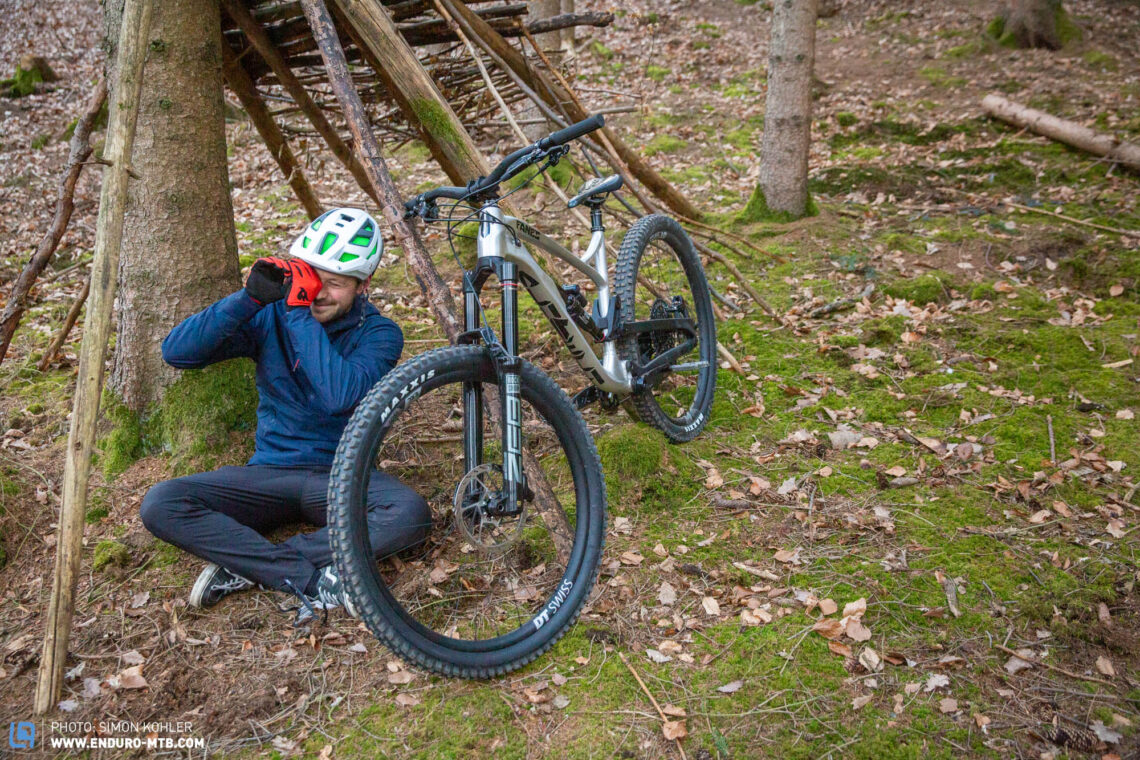
The Alutech Fanes 29 Custom on the trail
As soon as you swing your leg over the saddle, you can’t help but notice the unusual handlebar shape, with the extreme back sweep making you feel as if you were riding a chopper. While this feeling might be a little weird at first, you’ll get used to it after a short while, and it’s actually quite pleasant on long tours. The Alutech places you in a central pedalling position with very little pressure on your hands, placing you on top of the bike rather than integrating you between its wheels. Needless to say, this makes the Fanes a rather efficient climber, which is great, because descents are only found at the top of climbs. The rear suspension works sensitively and only bobs marginally, generating good traction in technical terrain. This allows you to negotiate short climbs without reaching for the climb switch, even on rougher terrain. Only on long, monotonous fire roads would we recommend activating the platform damping. On steep, technical climbs, the tall front end requires you to actively weight the front wheel to keep it tracking.
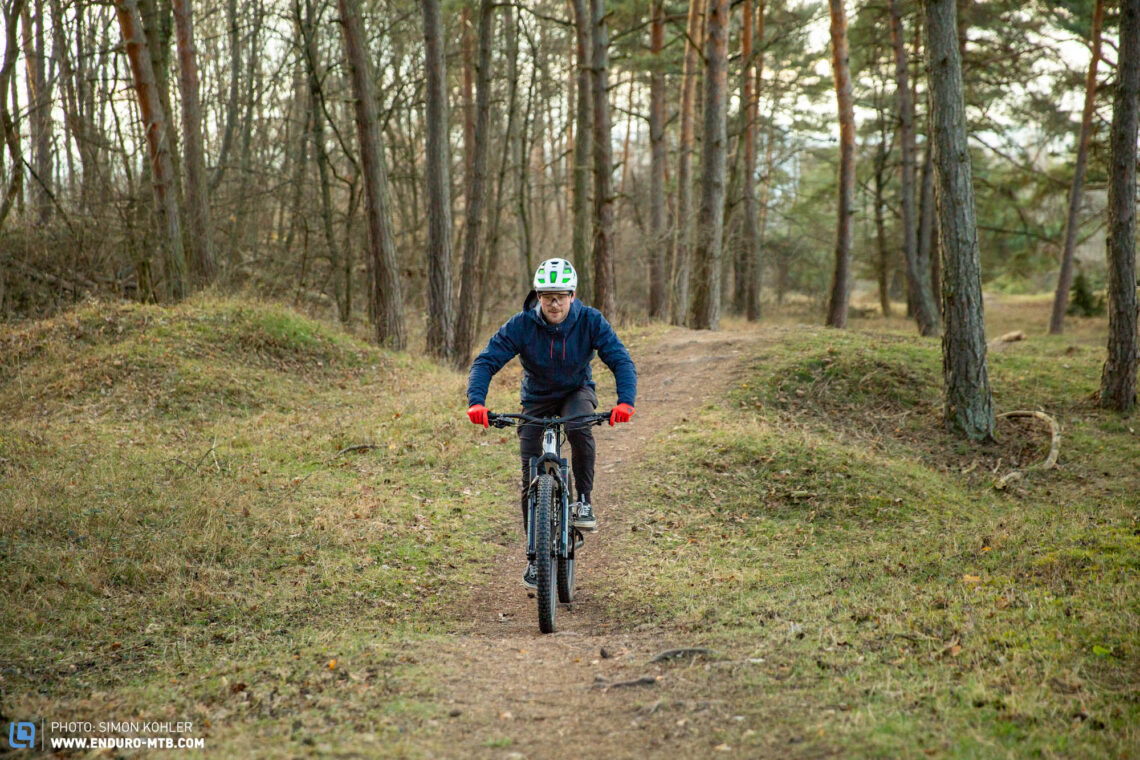
Thank goodness, every climb leads to a descent! However, that’s also where the handlebars show their dark side, placing your arms in a passive riding position with your elbows tucked in against the torso rather than pointing outwards in an aggressive position. This comes at the expense of stability, and restricts freedom of movement on the bike. On flowing trails, the agile handling plays to its strengths, with the stiff front-end and conservative 470 mm reach implementing fast direction changes rather eagerly. Only with hard compressions – for example when pumping through berms – the suspension lacks mid-stroke support, quickly rushing through its travel, sucking up the rider’s input like a sandbag in fast berms and compressions. For this reason, we ran 25% sag instead of the typical 30%, which improves the suspension’s mid-stroke support but still ensures a decent level of sensitivity, allowing you to generate speed by pumping through rollers and berms. That said, the suspension provides enough support to bail you out on botched landings and with nasty huck-to-flats.
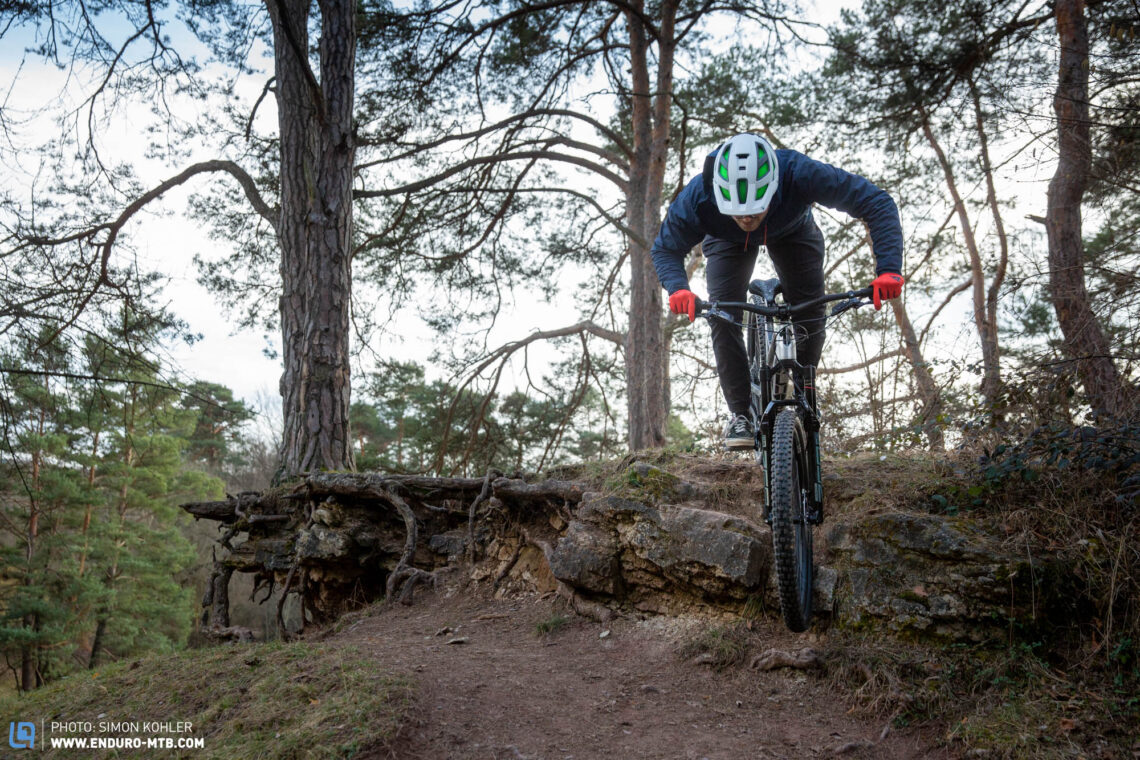
On steep trails, the Alutech Fanes inspires confidence, but places you on top of the bike rather than integrating you between its wheels. However, the massive stack of spacers under the stem and the tall handlebars somehow compensate for this feeling, preventing stressful OTB moments in steeper sections. When the going gets rough, the stiff, direct front-end becomes even more evident, which is mainly due to the combination of the carbon wheelset and the RockShox ZEB fork with its beefy 38 mm stanchions. While on one hand, the direct handling allows you to pick your lines through nasty rock gardens with surgical precision, on the other hand it provides strong feedback from the ground, especially in rough sections, leading to fatigue and arm pump relatively quickly and requiring a vigilant riding style to avoid mistakes. The weird handlebar shape doesn’t help either, placing your arms in a rather passive position. Fortunately, the steerer tube of our test bike is still long enough to add a few spacers under the stem, meaning that you could lift the cockpit and choose one of the handlebars with less rise in the configurator. Fact is, the Alutech forces you to pick your line carefully through the rough stuff, because it’s not very forgiving of mistakes. The sensitive rear suspension works efficiently but both the front- and rear-end provide strong feedback from the ground. While the direct response might feel a little overwhelming at the front, the active rear end helps you improve your riding skills. This comes in handy, because the eerie combination of thin tires and expensive carbon rims forced us to run high tire pressures, which reduces traction and control.
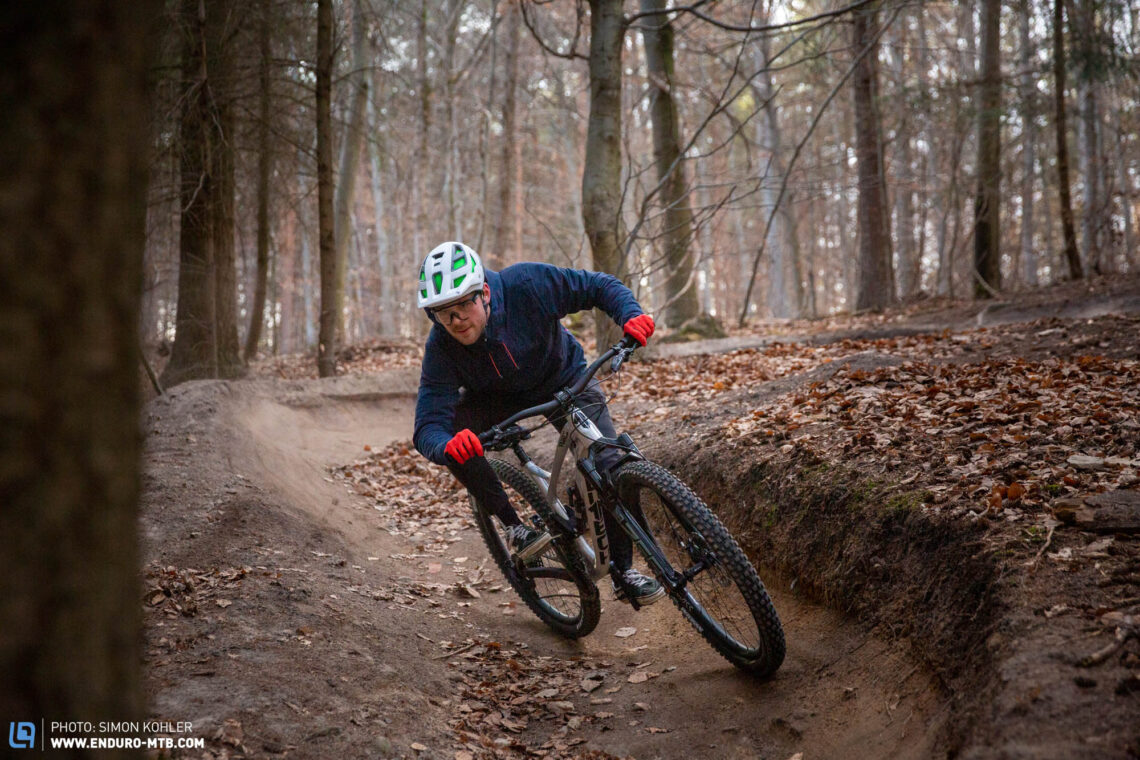
All in all, the Alutech Fanes is an agile yet potent 170 mm enduro rig, which makes an excellent companion for flowing trails with big jumps. It’s easy to lean into corners and yet potent enough to bail you out on botched landings, provided you set up the rear suspension with a tad less sag. In rough terrain, the Alutech needs an experienced rider who knows how to use the direct handling and feedback to their advantage.
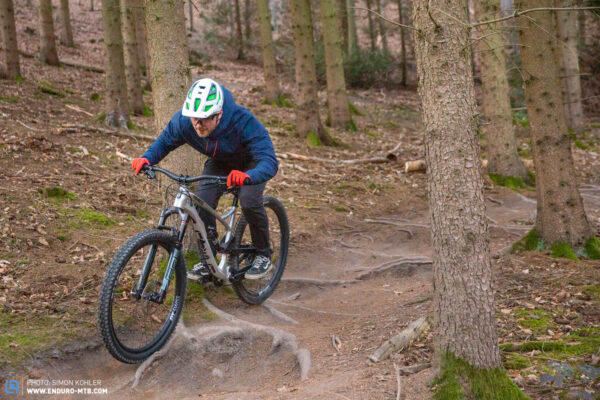
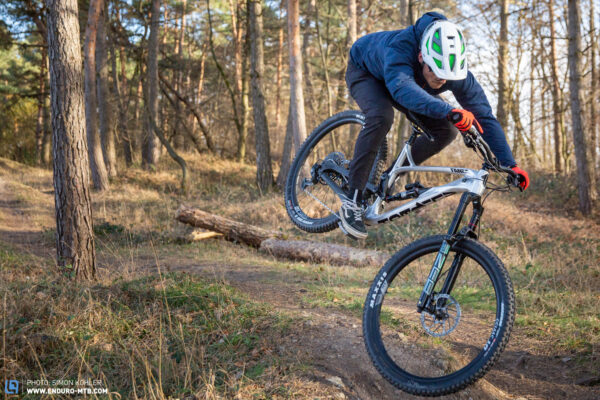
Our conclusions about the Alutech Fanes Custom 29
Without a tool mount or even bottle cage bosses, the Alutech’s frame is starting to seem a bit dated. The online configurator, on the other hand, is rather extensive and the prices are fair. Despite generating a very generous 170 mm of travel, the Fanes is easy to pedal. With its stiff front-end and playful handling, it responds to steering input willingly, allowing for spontaneous direction changes. Unfortunately, all of this comes at the expense of composure. Overall, the Alutech is a great option for riders who love to jump and draw creative lines through nasty rock gardens.
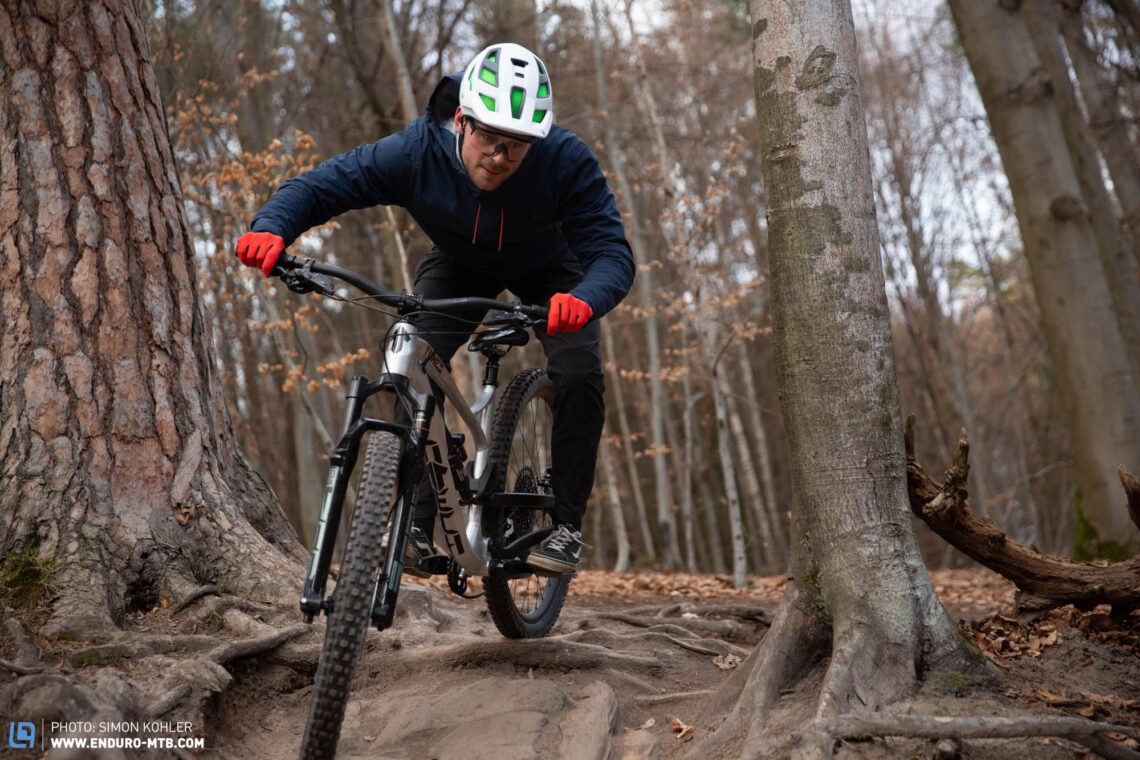
Tops
- Versatile configurator
- Agile, playful handling on the trail
- Solid climber
- Quiet riding companion
Flops
- No bottle cage mount
- Tire don’t do justice to the bike’s character and intended use
- Long seat tube
Tuning-Tipps: Select the ProTAPER or TwinWorks handlebars and raise the stem | Use more robust tires with tougher casing and with a softer rubber compound at the front | Run the shock at 25% sag | Upgrade to a bigger brake rotor at the rear
